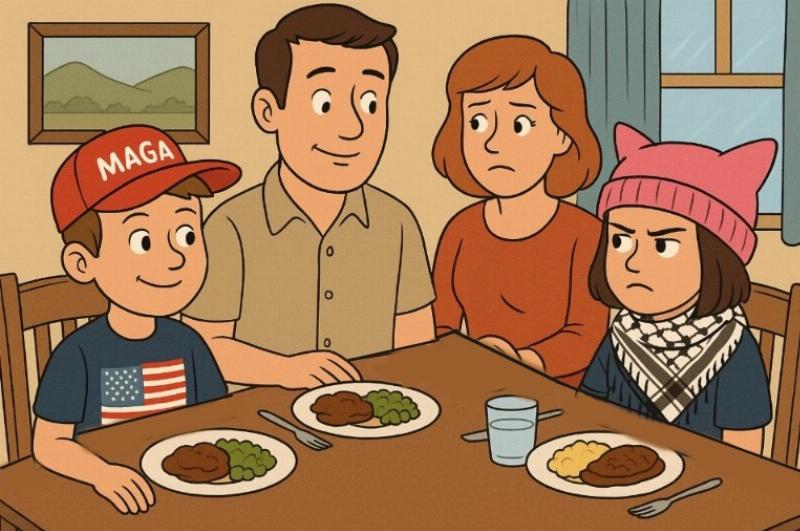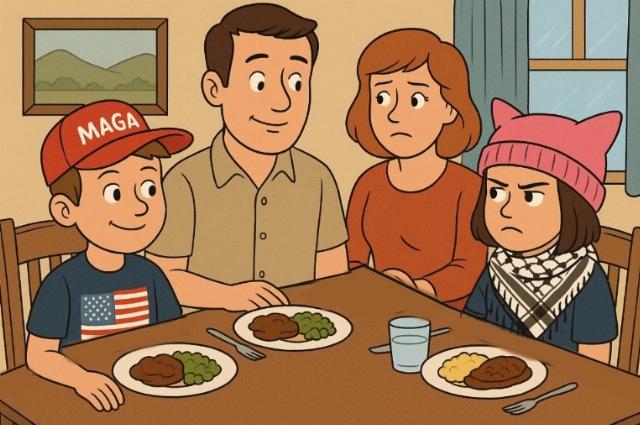


Political differences have always existed in the United States, but the divide now cutting through families, friendships, workplaces, and communities has taken on a sharper, more unyielding edge. A thread by X user @TNG9791, posted on August 4, brought that reality into painfully personal focus. In it, the author contrasted the values, work ethic, and worldview of her two adult children and, in doing so, offered an unvarnished glimpse into the forces driving America further apart.
The conservative child, she wrote, “works hard” and has been steadily employed since graduating from college. He recently bought his first home, refuses to ask for help, and even believes he should repay his parents for the cost of raising him. The liberal child, by contrast, sees capitalism as “evil” and resents the expectation of working through adulthood, preferring a life centered on hedonism rather than hard work.

Image created using AI.
This difference in attitudes is not just ideological; it shapes how each child approaches responsibility, independence, and family relationships. The thread described the relationship with the liberal daughter as “a roller coaster,” marked by her disdain for her parents’ support of Donald Trump and her expectation of lifelong financial backing. The author lamented that liberal “indoctrination,” in her view, has turned one of her children into “a stranger” and eroded the shared values she believes once held the country together.
This is not an isolated story. It reflects a much larger phenomenon. It’s one that science, sociology, and election returns all confirm. The nation’s ideological chasm is not just a matter of media influence, partisan spin, or cultural trends. Much of it is rooted in something far more fundamental: human biology.
For decades, research has shown that political orientation is not simply “taught” but strongly shaped by genetics. A landmark study in 2005 found that identical twins, who share nearly all their DNA, were far more likely to hold similar political beliefs than fraternal twins, even when raised in different environments. This work built on years of findings that certain traits — such as preference for order, risk tolerance, and openness to change — are passed down biologically.
By 2011, researchers had even identified genetic variations correlated with conservative political attitudes. These predispositions may influence why some voters prioritize tradition, national cohesion, and law-and-order policies. Such principles underpin much of Donald Trump’s appeal.
A 2013 study published in Political Psychology used data from the Minnesota Twin Registry, which includes around 8,000 twin pairs born between 1936 and 1955, to explore the influence of genetics on political beliefs. By comparing identical twins with fraternal ones, researchers found that genetic factors account for approximately 56-58% of the differences in political ideology.
This is not to say the environment plays no role. In fact, where children grow up, their community values, the media they consume, and the schools they attend can intensify existing predispositions. But it’s important to understand that such environmental factors are not neutral anymore. They have become more polarized themselves.
By the mid-1990s, political parties were already hardening along ideological lines. Republicans coalesced around limited government, family traditions, and resistance to progressive cultural change. Democrats leaned more heavily into identity politics, government expansion, and social progressivism. These shifts meant that children growing up in conservative households and those in liberal ones were living increasingly different realities.
Geographic self-sorting has only made the split more severe. In 2008, Bill Bishop’s The Big Sort revealed how Americans have been consciously choosing to live among people who share their values, from the churchgoing small towns of Texas to the progressive enclaves of the Pacific Coast. In 1976, San Francisco’s political balance was not so different from that of a rural county in Oregon. But over time, migration patterns created ideological strongholds, making it less likely for people to encounter and meaningfully interact with those who disagree.
This separation is not just about political affiliation; it’s about lifestyle. By 2020, conservatives and liberals were living strikingly different day-to-day lives, with Republicans more likely to value faith, rural living, and traditional family roles, while Democrats embraced urban, secular, and more fluid cultural norms.
Partisan animosity has surged alongside these changes. By 2016, 45% of Republicans viewed Democrats as a threat to the nation’s well-being, with Democrats returning the sentiment at nearly the same rate. In 2021, Pew Research reported that only 39% of Americans still identified as politically moderate. That figure has since fallen even further: a 2025 Gallup poll found just 34% of Americans now call themselves moderates, down from 43% in 1992.
The genetic piece makes this trend even more intractable. If political inclinations are, in large part, inherited, then no amount of bipartisan rhetoric will magically realign the population toward the center. Instead, as people continue to cluster into communities that reinforce their beliefs, and as national media and political leaders cater to these hardened bases, the divide will deepen.
This explains why calls for unity, however well-intentioned, often fall flat. A conservative who is biologically predisposed toward valuing stability, order, and tradition is unlikely to embrace sweeping cultural change simply because a centrist politician frames it as “common sense.” A liberal with a genetic leaning toward openness and novelty will see resistance to such change as “privilege”-driven obstructionism.
Politically segregated communities, polarized media ecosystems, and educational institutions that often lean heavily one way or the other do not just reflect the divide; they amplify it. Over time, they transform natural predispositions into hardened ideological identities.
Some Americans find this reality deeply troubling, hoping for a revival of cross-party cooperation. But the evidence suggests such hope is misplaced. This is not a temporary fever driven by a handful of polarizing figures. It is the product of both biology and decades-long social trends. The country is not simply arguing over policy; it is, in many ways, composed of two populations with fundamentally different lenses on reality itself.
The implications are profound. Political strategy in the years ahead will not be about persuading a vast middle, because that middle is shrinking. It will be about energizing those who are already ideologically committed and genetically inclined toward a particular worldview. For Republicans, and especially for Trump-aligned populists, this means doubling down on messages that resonate with the values of order, stability, national sovereignty, and cultural cohesion. For Democrats, it will mean doing the same with “diversity, equity, and inclusion.”
Neither side will likely admit how much of this divide is grounded in genetics. The science, however, suggests that political identity is often as fixed as eye color.
Environmental factors will continue to play a role, but given how polarized those environments have become, they are far more likely to reinforce existing leanings than to bridge them. And as Americans keep sorting themselves geographically, culturally, socially, and, of course, politically, the echo chambers will only grow louder.
The United States will keep producing families with relatives bound by blood, but separated by values so different they might as well have been raised on opposite sides of the world. For some, that is a tragedy. For others, it is simply the new reality. Either way, it is the path the nation is on, and there is no sign of it reversing.
Dr. Joseph Ford Cotto hosts and produces News Sight, speaking the data-driven truth about economic and political issues that impact you. During the 2024 presidential election, he created the Five-Point Forecast, which correctly predicted Trump’s national victory and the outcome in all swing states. The author of numerous nonfiction books, Cotto holds a doctorate in business administration and is a Lean Six Sigma Certified Black Belt. During 2014, HLM King Kigeli V of Rwanda bestowed a hereditary knighthood upon him. It was followed by a barony the next year.
